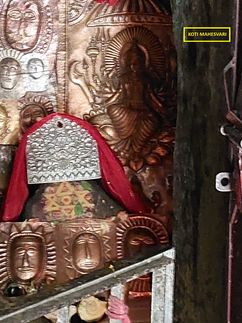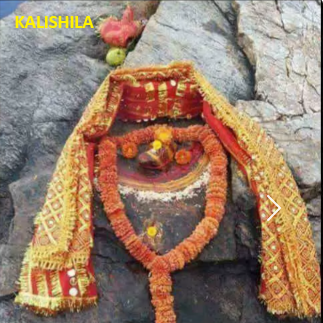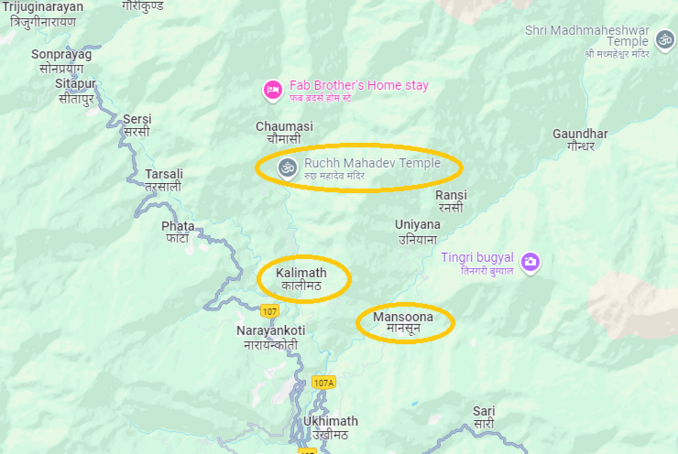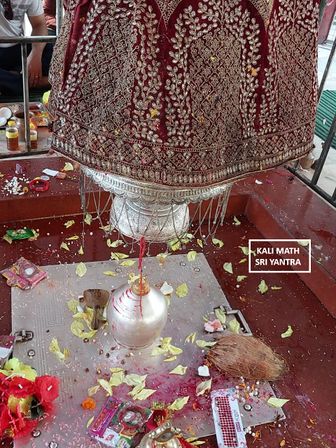Devi Mahatmya (देवीमाहात्म्यम्)
Shakta Sampradaya is an ancient Indian Sampradaya with the Devi Mahatmya (The Greatness of the Divine Mother) as one of its important works elucidating the concept and worship of the Supreme Being as the Divine Mother.
सम्प्रदायमूलम् ॥ Origin
The roots of this sampradaya can be traced to the Rigveda where the Ambhrini sukta (10.125) and Ratri sukta (10.127) point towards this. The Devi Upanishad (belonging to the Atharvaveda) amongst the 108 Upanishads mentioned in the Muktikopanishad and the Tantras (Shakta Agamas) have expounded this sampradaya in greater detail.
Gradually, the conception of Durga as the primordial Shakti and of Lakshmi and Sarasvati as Her aspects became popular and thus, the devotee visualized the triple aspect of power, beneficence and wisdom in Durga[1].
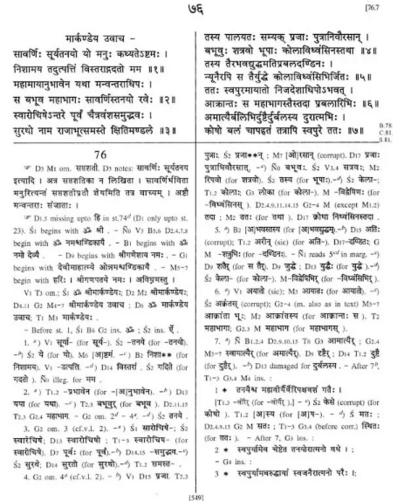
ग्रन्थमूलम् ॥ Markandeya Purana
The Devi Mahatmya is considered as a part of the Markandeya Purana (chapters 78-90 of Venkatesh Press edition; chapters 81-93 of K M Banerjee edition of 1862)[3]. The Critical Edition of the Markandeya Purana in two volumes, edited by M. L. Wadekar was published from Oriental Institute, Vadodara in 2011. It was prepared from twenty four Manuscripts, selected from out of a total of forty nine Manuscripts collated for the purpose.
On the basis of subject-matter, the eighteen Mahapuranas are divided as six Sattvika Puranas dealing with Vishnu, six Tamasa Puranas related to Shiva and six Rajasa Puranas concerning Brahma. Markandeya Purana is enumerated as one of the Rajasa Puranas[4]. It is one of the early puranas and may be assigned to a date between the fourth to sixth century AD[5].
देवीमाहात्म्यम् ॥ Devi Mahatmya
There are more than forty seven commentaries on the Devi Mahatmya like, Anvayartha-prakashika by Ekanath Bhatta, Kavi-vallabha by Kamadeva, Siddhanta-manjari by Krishnananda, Tattva-prakashika by Gopal Mishra, Chidananda-keli-vilasa by Gaudapada and so on.
It is also known by two more names: Durga Saptashati (since it contains sapta-shata or 700 verses extolling the greatness of Mother Durga) and Chandi (since it deals with the exploits of the fierce Goddess Chandi or Chandika to protect the surrendering devotee from contrary forces.)[6]
दुर्गा देवी ॥ Durga Devi
The vowels and consonants used in the word 'Durga' have different connotations. The consonant ‘d’ implies that Durga destroys demons (daitya), vowel ‘u’ means that she wards off all obstacles (vighna), consonant ‘r’ means that she protects from all sorts of diseases (roga), consonant ‘g’ means that she burns all sins (paapa) and vowel ‘aa’ means that she destroys all fears (bhaya). The Goddess herself says that whosoever shall pray to Her constantly with a concentrated mind through these hymns, She shall put down his every trouble doubtlessly.
तस्याहं सकलां बाधां नाशयिष्याम्यसंशयम् ॥12.1||[7] tasyāhaṁ sakalāṁ bādhāṁ nāśayiṣyāmyasaṁśayam//
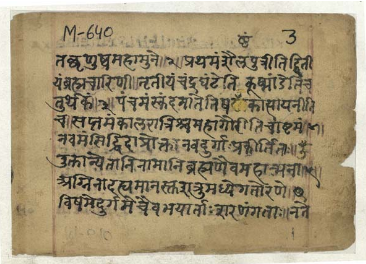
The Devi-kavacha mentions the Nine Durga as follows:
- Shailaputri – The Goddess who was born to the Himalaya as his daughter after severe penances.
- Brahmacharini – This aspect of the Goddess helps the aspirant towards the Supreme experience as is expressed also through the etymology of this word:
ब्रह्म चारयितुं शीलमस्या: - brahma cārayituṁ śīlamasyāh[6]
She had bestowed Brahma-jnana to Indra as recorded in the Kenopanishad,
सा ब्रह्मेति होवाच ब्रह्मणो वा एतद्विजये महीयध्वमिति ततो हैव विदाञ्चकार ब्रह्मेति ॥ १ ॥[9] sā brahmeti hovāca brahmaṇo vā etadvijaye mahīyadhvamiti tato haiva vidāñcakāra brahmeti//
Meaning: She said, “It is Brahman indeed. Attain glory in the victory of Brahman.” From her words only, he learned that it was Brahman.
- Chandraghanta – Meaning, the sound of the ghanta. Here, bell is the ensemble of sounds of all instruments which is Shabda-brahman or Nada-brahman.
- Kushmanda – Kushma is fearful affliction and anda is stomach. So, Mother bears all the adversities in her stomach to render peace to her devotees. Even the text says:
उपसर्गानशेषांस्तु महामारीसमुद्भवान्। तथा त्रिविधमुत्पातं माहात्म्यं शमयेन्मम॥(12.8)[7] upasargānaśeṣāṁstu mahāmārīsamudbhavān। tathā trividhamutpātaṁ māhātmyaṁ śamayenmama॥
Meaning: May my glories quell all epidemic calamities, as also the threefold natural calamities.
- Skandamata – The Mother who is also Knowledge Incarnate.
सा याचिता च विज्ञानं तुष्टा बुद्धिं प्रयच्छति॥ (12.37)[7] sā yācitā ca vijñānaṁ tuṣṭā buddhiṁ prayacchati/
Meaning: And when entreated, she bestows Supreme Knowledge, and when propitiated, she bestows prosperity.
- Katyayani – is the presiding deity of Vrindavan and she helps the aspirant in the path of devotion to Krishna (Krishna-bhakti-dana).
- Kalaratri – This aspect of the Mother is delineated in the text itself:
व्याप्तं तयैतत्सकलं ब्रह्माण्डं मनुजेश्वर। महाकाल्या महाकाले महामारीस्वरूपया॥
सैव काले महामारी सैव सृष्टिर्भवत्यजा। स्थितिं करोति भूतानां सैव काले सनातनी॥ (12.38-39)[7]
vyāptaṁ tayaitatsakalaṁ brahmāṇḍaṁ manujeśvara। mahākālyā mahākāle mahāmārīsvarūpayā॥ saiva kāle mahāmārī saiva sr̥ṣṭirbhavatyajā। sthitiṁ karoti bhūtānāṁ saiva kāle sanātanī॥
Meaning: By her, the Mahakali, who takes the form of the great destroyer at the end of time, all this cosmic sphere is pervaded. She indeed takes the form of the great destroyer at the proper time. She, the unborn, indeed becomes this creation, She herself, the eternal being, sustains the beings at another time.
- Mahagauri – is Lakshmi along with Narayana.
- Siddhidatri – grants success to the aspirant on all fronts[10] and even the text says:
ददाति वित्तं पुत्रांश्च मतिं धर्मे गतिं शुभाम्॥(12.41)[7] dadāti vittaṁ putrāṁśca matiṁ dharme gatiṁ śubhām॥
Meaning: She bestows wealth and sons, a righteous mind and prosperous life.
ग्रन्थविधानम् ॥ Structure
The Devi Mahatmya has thirteen adhyayas or chapters divided into three Charitras or major sections devoted to the exposition of the greatness of the three aspects of the Devi. These three sections reflect the spiritual progress of the sadhaka through the destruction of his subtle, subtler and subtlest (Tamasika, Rajasika and Sattvika) obstacles by various forms of the Divine Energy. So, the first section comprises of the first chapter; the second section includes chapters two, three and four and chapters five to thirteen form the third section.
प्रथमचरित्रम् ॥ Prathama Charitra (Chapter 1): Maha-Kali
Chapter 1 – The Prathama Charitra is attributed to the Maha-Kali aspect of the Goddess who slays the demons Madhu and Kaitabha (Madhu-kaitabha-vadha). On a subtler level, Madhu and Kaitabha represent the Tamasika Ahankara. They are also considered as the Avarana (Concealing power) and Vikshepa (Projection) aspects of Avidya in Vedanta and also Rajas and Tamas guna according to the Samkhya terminology[11].
The figure of Mother Kali has four hands bearing sword and skull in two left hands and the other two right hands bestow boons and fearlessness on the devotees. Thus, she is both peace and combat simultaneously. She wears a garland of fifty skulls which are actually the fifty alphabets of Sanskrit. So, the skull-garland is the symbol of powerful mantras. She has three eyes i.e. Moon, Sun and Fire, through which she destroys darkness and can perceive the past, present and future. Her red tongue implies the active Rajo-guna and white teeth are the symbol of placid Sattva-guna. So, the act of biting her tongue with her white teeth suggests that the practitioner should keep his Rajo-guna in check with the help of the Sattva-guna[12].
मध्यमचरित्रम् ॥ Madhyama Charitra (Chapters 2, 3 and 4): Maha-Lakshmi
The Madhyama Charitra is attributed to the Maha-Lakshmi aspect of the Goddess who is worshipped as Durga in autumn (mid September to mid November)[1]. The contents of the Madhyama Charitra are as follows:
Chapter Two – Mahishasura-sainya-vadha – Slaughter of the armies of Mahishasura
Chapter Three – Mahishasura-vadha – The slaying of Mahishasura, who depicts the self-centred mentality (Rajasika Ahankara) of the human being[13].
Chapter Four – Shakradi-stuti – Praises by Shakra and others.
उत्तमचरित्रम् ॥ Uttama-Charitra (Chapters 5 to 13): Maha-Sarasvati
The Uttama Charitra contains the exploits of the Maha-Sarasvati aspect of the Goddess and deals with the following kathas.
Chapter Five – Devi-duta-samvada – Devi’s conversation with the messenger
Chapter Six – Dhumralochana-vadha – The Slaying of Dhumra-lochana
Chapter Seven – Chanda-munda-vadha – The Slaying of Chanda and Munda
Chapter Eight – Raktabija-vadha – The Slaying of Raktabija
Chapter Nine – Nishumbha-vadha – The Slaying of Nishumbha
Chapter Ten – Shumbha-vadha – The Slaying of Shumbha (Sattvika Ahankara[14])
Chapter Eleven – Narayani-stuti – Hymn to Narayani who destroys the demoniac ignorance through her Knowledge.
Chapter Twelve – Phala-stuti – Eulogy of the Merits
Chapter Thirteen – Suratha-vaishya-vara-pradana – The bestowing of boons to Suratha and Vaishya[7]. The key details related to the text of Devi Mahatmya can be summarized as follows:
| CHARITRA | RISHI | DEVATA | CHANDA | SHAKTI | BIJA | TATTVA | SVARUPA | SHAKTI |
| Prathama | Brahma | Maha-kali
(10 arms) |
Gayatri | Nanda | Rakta-dantika | Agni | Rgveda | Iccha-shakti |
| Madhyama | Vishnu | Maha-lakshmi (18 arms) | Ushnik | Shakambhari | Durga | Vayu | Yajurveda | Kriya-shakti |
| Uttama | Rudra | Maha-sarasvati (8 arms) | Anushtup | Bhima | Bhramari | Surya | Samaveda | Jnana-shakti |
| 700 verses | Narada | Sri Dakshinamurti | Gayatri | Svaha | Hrim |
विषयविस्तारः ॥ Contents
The first section starts with the story of a king, Suratha by name, and the merchant Samadhi, both of whom had been deprived of their wealth and possessions by their own near and dear ones. They met at the hermitage of the sage Sumedhas, to where they had come, seeking peace. After hearing from each other about the tragedies that had struck them, they approached the sage Sumedhas, with the question as to why they were still mentally attached to their possessions and their relatives even though the latter had deliberately wronged them. In his long reply, the sage described this blind attachment and infatuation as the direct result of the power of moha or maya, the spell cast by the Devi on all the living beings. When their curiosity to know more was aroused, the Sage started describing in detail, the stories related to her.
The first story concerns the Devi as Yoga-nidra. At the end of a kalpa (cycle of creation), Narayana was in deep sleep. Using this opportunity, two demons Madhu and Kaitabha, tried to attack and kill Brahma (the creator, seated on the navel-lotus of Narayana). Brahma prayed to Yoga-nidra (an aspect of Kali), to come out of Narayana so that he could wake up. She obliged, appeared before him and then disappeared. Narayana then killed the demons and rescued Brahma. With this, ends the Prathama-charitra or the first section.
The second section known as the Madhyama-charitra contains the story of Mahishasura, the king of the asuras or demons. He had usurped the kingdom of Svarga and driven away all the deities including Indra. Then these deities under the leadership of Brahma came to Vishnu and Shiva and recounted their tale of woe. As the two deities got angry, and a brilliant light emerged from their faces, the energies of all the others too emerged similarly out of them, merging into one huge mass of brilliant blazing light and power, which took the form of the Goddess Durga. As all the deities equipped her with their respective weapons, she went to Mahishasura, challenged him for fight and ultimately killed him. The Svarga was restored to the deities. Devi Durga promised to come to the rescue of the deities whenever they called upon her for help. Thus ends the second section.
The last section called the Uttama-charitra begins with the outrageous misdeeds of the demon brothers, Shumbha and Nishumbha, who too, like Mahishasura, had forcibly occupied the Svarga and driven away the deities. Remembering the promise given by the Devi, the deities prayed to her. She manifested herself as Kaushiki Durga, of bewitching beauty and started roaming about the Himalayan region. She was noticed by two servants of Shumbha who informed him about her presence in his kingdom, stressing her captivating beauty. When Shumbha sent messengers to her with a proposal for marriage, she informed them about her vow, taken out of ignorance, to marry only him who will conquer her in combat! All attempts by Shumbha’s men, including several generals of his armed forces, to capture her, dead or alive, ended in total disaster. The Devi, with her emanations like Brahmani, Narayani, Kaumari and others, successfully killed all the demons like Chanda, Munda and Raktabija. Finally, after withdrawing them into herself, she despatched both Nishumbha and Sumbha, to the world of Yama, the God of death, thereby ridding the world, of a great terror.
Even today, places in Uttarakhand bear testimony to this event. Mansuna (in Ukhimath) which was the capital of Raktabija (8.40) is just opposite to Kalishila, the emergence spot of Kali. The mountain became black due to the anger of Parvati where she became Kali (7.5-6). Mother vanquished the demon (8.62) between the two places namely, Mansuna and Kotma. The fiery Goddess was still in a hostile state after slaughtering Raktabija. So, Shiva then decided to lie down beneath as Ruksha Mahadeva at Kotma to calm her down. As Kali placed her feet on Shiva, she bit her tongue in embarrassment and is still worshipped in the temple of Koti Maheshvari. She then proceeded to Kalimath on the banks of Saraswati river in Rudraprayag. A Sri Yantra (silver plate) is covering the point where Maha-kali, Maha-lakshmi and Maha-sarasvati entered the Earth (12.32) at Kalimath as if in profound meditation.
The verses[7] indicated in the above paragraph are as follows:
योद्धुमभ्याययौ क्रुद्धो रक्तबीजो महासुरः॥ (8.40) - yoddhum abhyāyayau kruddho raktabījo mahāsuraḥ॥
Meaning: The great asura Raktabija strode forward to fight in wrath.
ततः कोपं चकारोच्चैः अम्बिका तानरीन्प्रति। कोपेन चास्या वदनं मषीवर्णमभूत् तदा॥7.5||
भ्रुकुटीकुटिलात् तस्या ललाटफलकाद्द्रुतम्। काली करालवदना विनिष्क्रान्तासिपाशिनी॥7.6||
tataḥ kopaṁ cakāroccaiḥ ambikā tānarīnprati। kopena cāsyā vadanaṁ maṣīvarṇamabhūt tadā॥
bhrukuṭīkuṭilāt tasyā lalāṭaphalakāddrutam। kālī karālavadanā viniṣkrāntāsipāśinī॥
Meaning: Thereupon Ambika became terribly angry with those foes, and in her anger her countenance then became dark as ink. Out from the surface of her forehead, fierce with frown, issued suddenly Kali of terrible countenance, armed with a sword and noose.
स पपात महीपृष्ठे शस्त्रसंघसमाहतः। नीरक्तश्च महीपाल रक्तबीजो महासुरः॥ (8.62) sa papāta mahīpr̥ṣṭhe śastrasaṁghasamāhataḥ। nīraktaśca mahīpāla raktabījo mahāsuraḥ॥
Meaning: Stricken with a multitude of weapons and bloodless, the great asura (Raktabija) fell on the ground, O King.
पश्यतामेव देवानां तत्रैवान्तरधीयत॥ (12.32) paśyatāmeva devānāṁ tatraivāntaradhīyata॥
Meaning: Chandika vanished on that very spot even as the Devas were gazing on.
After listening to these exploits of the Devi and learning from the Sage Sumedhas the methods of worshipping her to get her grace, Suratha and Samadhi practiced severe austerities for three years. They got her vision and obtained, through her grace, what they wanted. Suratha got back his kingdom whereas Samadhi succeeded in attaining Supreme Knowledge for which alone he had hankered.
देवीमाहात्म्ये स्तुतयः ॥ Stutis in Devi Mahatmya
The work contains four hymns which are exquisitely beautiful and are a signal contribution to the hymnal literature. They are:
- Brahma’s hymn to Yoga-nidra – Chapter 1, verses 72-87. This hymn is famous as the Vishveshvari-stuti.
- Hymn by all deities, led by Indra, expressing their gratefulness after Mahishasura was killed by Durga – Chapter 4, verses 1-27. This hymn is known as Indradi-stuti or Mahisha-hantri-stuti.
- Hymn by all the deities, on the bank of the river Ganga in the Himalayas – Chapter 5, verses 8-82. This hymn is called Aparajita-stotra.
- Hymn by all the deities, after Shumbha and Nishumbha were killed – Chapter 11, verses 1-35. This hymn is the famous Narayani-stuti.
वैधिकप्रयोगः ॥ Ritual Usage
The entire Devi Mahatmya is considered as a mantra and a ritual recitation of the same is recommended for the fulfilment of one’s desires. Such a ritual recitation normally consists of the following procedure:
- Achamana (ceremonial sipping of water before beginning any religious rite)
- Pranayama (breath-control)
- Sankalpa (religious resolve stating the details of the ritual)
- Dipa-sthapana (lighting a lamp and offering a simple worship to it, considering as a representation of the Devi)
- Worship of the Devi Mahatmya book used for the ceremonial chanting,
- Repetition of the Shapoddhara-mantra to ward off the effects of the curses of the sages of yore, if any, and then the actual recital.
The recital should include:
- Kavacha-stotra (the verses which protect like an armour) written by the Brahmin Harihara
- Argala-stotra – This hymn opens the gate of success as if by opening the bolt fastening the door by destroying all the obstructions in the form of papa. So, after the chanting of this hymn, external objects will be unable to mentally disturb the reciter. This hymn[7] has the famous line –
रूपं देहि जयं देहि यशो देहि द्विषो जहि॥ rūpaṁ dehi jayaṁ dehi yaśo dehi dviṣo jahi॥
Meaning: May the Mother bestow upon us grace, victory against all odds, unblemished glory and destroy all adversaries,
- Kilaka-stotra – This hymn wards off all the obstacles to ensure success (in dharma, artha, kama and moksha) of the chanter[15]
- repetition of the well known Navaarna-mantra
- recital of the Ratri-sukta (Rishi – Ratri Bhaaradvaajii, Devata (Subject Matter) – Ratri, Chanda (Metre) - Gayatri)
- the entire text of the Devi Mahatmya
- the Devi-sukta (Rishi – Vak Ambhrini, Devata – Atma, Chanda – Trishtup and Jagati)
- the Rahasya-traya (Pradhanika, Vaikrtika and Murti Rahasyas)
- Shapoddhara-mantra and
- Kshama-prarthana (recital of the Aparadha-kshamapana-stotra – hymn for forgiveness for omissions and wrong reading).
There are several modes of chanting for specific purposes like freedom from diseases, attaining wealth or position and so on. Recitations called Shata-chandi (ten brahmins reciting it for four days—once on the first day, twice on the second day, thrice on the third day and four times on the fourth day) and Sahasra-chandi (with one hundred Brahmins, the procedure being similar) are forms of congregational worship and are done for the welfare of the society. A thousand Brahmins are to be fed and one hundred cows are to be donated on such occasions. In all these rites, homa (offering of oblations into a duly consecrated fire) is also done[16].
मूर्तिविवरणम् ॥ Iconography
The study of early relief of the deity indicates the developmental aspect of the iconic-motif. In Orissa, we find reflection of evolution of all types of Durga and Mahishamardini icons in sculptural representations. We find her images having two to twenty arms with various ayudhas (weapons) ranging from very early time to modern period in Orissa. From sixth to seventh century onwards, we find her representation in most Shiva and Shakta temples. The standing posture of the Goddess corresponds to her Devi Mahatmya description. We find different representations of the fighting scene in the Mahabalipuram and Ellora panels.
Kanyakumari is the point from which India, Australia and Antarctica split 160 million years ago. Kanyakumari is one of the oldest shrines in Tamilnadu dedicated to Durga. There are panels representing Mahishamardini carved in the monolithic and cave temples of South India like Madattukkovil, Namakkal, Mamallapuram etc. circa seventh to ninth centuries during the Pallava and Pandya reign. The larger temples of the Pallava and early Chola periods had shrines dedicated to the Sapta-matrikas (Seven Mothers) namely, Brahmi, Maheshvari, Kaumari, Vaishnavi, Varahi, Mahendri and Chamunda.
Durga worship was popular in India from the age of Ramayana, Mahabharata and Puranas. Durga puja in idol was prevalent in present Bangladesh since tenth or eleventh century AD. Krishnananda Agamavagisha (1485-1533) is believed to have conceived and introduced through divine inspiration the image of Kali as she is now worshipped in Bengal.
द्विभुजा ॥ Two-armed
Miniature stone-reliefs of two armed Durga engaged in war with Mahisasura un-earthed from Bhita by Sir John Marshal are attributed to the Gupta period. Bhumara Shiva temple in Madhya Pradesh has two and four armed Mahisha-mardini of sixth century AD.
चतुर्भुजा ॥ Four-armed
A four armed brass image containing an inscription of the time of Meruvarman ruler of Chamba (8 Century A.D.) is excellent in composition.
षड्भुजा ॥ Six-armed
Rajshahi Varendra Research Society has a six-armed Durga statue.
अष्टभुजा ॥ Eight-armed
The Ellora specimen shows the eight armed Devi engaged in war riding her mount lion. The Haripur image of Mayurbhanj, Orissa also shows the eight armed Durga in a more aggressive pose. Mahabalipuram has an eight armed Mahishamardini of seventh century AD.
दशभुजा ॥ Ten-armed
Nagod in Madhya Pradesh and Badami in Bijapur, Bombay have the ten-armed Mahishamardini.
द्वादशभुजा ॥ Twelve-armed
A metallic Devi statue at Keshapur in Dinajpur has twelve arms. Udayagiri caves have twelve-armed Mahisha-mardini since fourth century. We find similar representation of twelve armed deity in an earlier relief carved on the facade of Chandragupta Cave at Udayagiri (Bhilsa, Madhya Pradesh)[17].
सप्तश्लोकी चण्डी ॥ Sapta-Shloki Chandi
The essence of the Durga Saptashati (700 verses) can be condensed in the following seven verses of the Devi Mahatmya[7] itself.
महामाया हरेश्चैषा तया सम्मोह्यते जगत् । ज्ञानिनामपि चेतांसि देवी भगवती हि सा ॥(1.55) mahāmāyā hareścaiṣā tayā sammohyate jagat । jñānināmapi cetāṁsi devī bhagavatī hi sā ॥
Meaning: This Mahamaya is the Yoganidra (the tamasika power) of Vishnu, the Lord of the world. The world is deluded by her and forcibly drawing the minds of even the wise, she, the Bhagavati, throws them into delusion.
दुर्गे स्मृता हरसि भीतिमशेषजन्तोः, स्वस्थैः स्मृता मतिमतीव शुभां ददासि । दारिद्र्यदुःखभयहारिणि का त्वदन्या, सर्वोपकारकरणाय सदार्द्रचित्ता ॥ (4.17) durge smr̥tā harasi bhītimaśeṣajantoḥ, svasthaiḥ smr̥tā matimatīva śubhāṁ dadāsi। dāridryaduḥkhabhayahāriṇi kā tvadanyā, sarvopakārakaraṇāya sadārdracittā ॥
Meaning: When called to mind in a difficult situation, you remove fear for every person. When called upon by those in happiness, you bestow a mind still further pious. Which Goddess but you, O Dispeller of poverty, pain and fear, has an ever sympathetic heart for helping everyone?
सर्वमङ्गलमाङ्गल्ये शिवे सर्वार्थसाधिके । शरण्ये त्र्यम्बके गौरि नारायणि नमोऽस्तु ते ॥ (11.10) sarvamaṅgalamāṅgalye śive sarvārthasādhike । śaraṇye tryambake gauri nārāyaṇi namo'stu te ॥
Meaning: Salutation be to you, O Narayani, O you who are the good of all good, O auspicious Devi, who accomplish every object, the giver of refuge, O three-eyed Gauri!
शरणागतदीनार्तपरित्राणपरायणे । सर्वस्यार्तिहरे देवि नारायणि नमोऽस्तु ते ॥ (11.12) śaraṇāgatadīnārtaparitrāṇaparāyaṇe । sarvasyārtihare devi nārāyaṇi namo'stu te ॥
Meaning: Salutation be to you, O Narayani, O you who are intent on saving the dejected and distressed that take refuge under you. O you, Devi, who remove the sufferings of all!
सर्वस्वरूपे सर्वेशे सर्वशक्तिसमन्विते । भयेभ्यस्त्राहि नो देवि दुर्गे देवि नमोऽस्तु ते ॥ (11.24)
sarvasvarūpe sarveśe sarvaśaktisamanvite । bhayebhyastrāhi no devi durge devi namo'stu te ॥
Meaning: O Queen of all, you who exist in the form of all, and possess every might, save us from error, O Devi. Salutation be to you, Devi Durga!
रोगानशेषानपहंसि तुष्टा, रुष्टा तु कामान् सकलानभीष्टान् । त्वामाश्रितानां न विपन्नराणां, त्वामाश्रिता ह्याश्रयतां प्रयान्ति ॥ (11.29) rogānaśeṣānapahaṁsi tuṣṭā, ruṣṭā tu kāmān sakalānabhīṣṭān । tvāmāśritānāṁ na vipannarāṇāṁ, tvāmāśritā hyāśrayatāṁ prayānti ॥
Meaning: When satisfied, you destroy all illness; but when wrathful you (frustrate) all the longed-for desires. No calamity befalls men who have sought you. Those who have sought you become verily a refuge of others.
सर्वाबाधाप्रशमनं त्रैलोक्यस्याखिलेश्वरि । एवमेव त्वया कार्यमस्मद्वैरिविनाशनम् ॥ (11.39) sarvābādhāpraśamanaṁ trailokyasyākhileśvari । evameva tvayā kāryamasmadvairivināśanam ॥
Meaning: O Queen of all, in this same manner, you must destroy all our enemies and all the afflictions of the three worlds.
The Devi-mahatmya is chanted on sacred occasions, especially during the Durga Puja (Navaratri). The poems which describe the Deity as the child of the worshipper, as in the Agamani (welcome) and Vijaya (farewell) songs of the Goddess Durga have indeed a peculiar spiritual appeal of their own and continue to inspire generations.
References
- ↑ 1.0 1.1 Haridas Bhattacharyya (2001), The Cultural Heritage of India, Volume IV – The Religions, Calcutta: The Ramakrishna Mission Institute of Culture.
- ↑ M. L. Wadekar (2011), The Critical Edition of the Markandeya Purana in two volumes, Vadodara: Oriental Institute.
- ↑ Pandurang Vaman Kane (1974), History of Dharmasastra, Vol V (Part I), Poona: Bhandarkar Oriental Research Institute.
- ↑ Uma Shankara Sarma Rsi (2004), Samskrta Sahitya ka Itihasa, Varanasi: Choukhamba Bharati Academy.
- ↑ Pandurang Vaman Kane (1962), History of Dharmasastra, Vol V (Part II), Poona: Bhandarkar Oriental Research Institute.
- ↑ 6.0 6.1 Vaman Shivaram Apta (1997), Sanskrit-Hindi Kosha, Delhi: Oriental Book Centre.
- ↑ 7.0 7.1 7.2 7.3 7.4 7.5 7.6 7.7 7.8 Swami Jagadiswarananda (1989), Devi Mahatmyam, Madras: Sri Ramakrishna Math.
- ↑ Lalchand Research Library Ancient Indian Manuscript Collection, DAV College, Chandigarh – https://dav.splrarebooks.com/
- ↑ Kenopanishad, Khanda 4
- ↑ Sri Satyadeva (1365), Sadhan Samar, Part 1, Kolkata: Sadhan Samar Karyalaya.
- ↑ Swami Jagadishwarananda (2003), Sri Sri Chandi, Kolkata: Udbodhan Karyalaya.
- ↑ Mahanamavrata Brahmachari (1988), Chandi-chinta, Kolkata: Sri Mahanamavrata Cultural and Welfare Trust.
- ↑ Sri Satyadeva (1333), Sadhan Samar, Part 2, Kolkata: Sadhan Samar Karyalaya.
- ↑ Sri Satyadeva (1353), Sadhan Samar, Part 3, Kolkata: Sadhan Samar Karyalaya.
- ↑ Girijesa Kumara Dixita (2003), Durga-Saptashati, Varanasi: Sampurnananda Sanskrit University.
- ↑ Swami Harshananda (2008), A Concise Encyclopaedia of HINDUISM, Volume I, Bangalore: Ramakrishna Math.
- ↑ C.B. Patel (2008), Mahisamardini Durga-Antiquity and Iconography, Orissa: Orissa Review.

